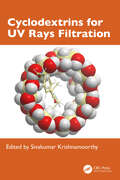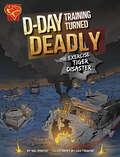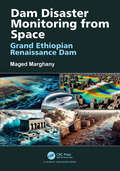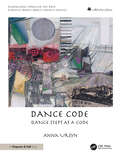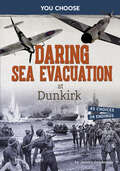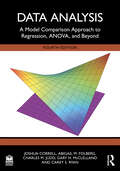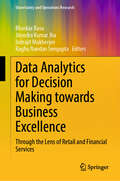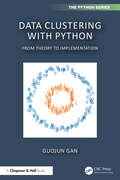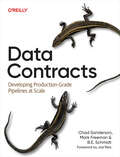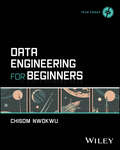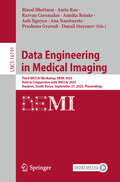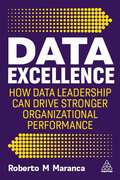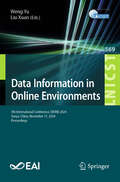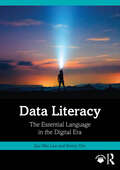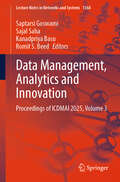- Table View
- List View
Cyclodextrins for UV Rays Filtration
by Sivakumar KrishnamoorthyTraditional UVR absorbers pose environmental and health risks due to their volatility, solubility, and toxicity. High concentrations are needed for effective UV filtration, leading to environmental accumulation. Safer alternatives, like cyclodextrin complexation, can enhance UV filtration while reducing absorber concentration. Cyclodextrin complexation offers a promising solution by enhancing UV filtration efficiency while reducing the required concentration of UVR absorbers.Cyclodextrins for UV Rays Filtration addresses a critical gap in photoprotection research by offering a comprehensive exploration of how cyclodextrins enhance UVR filtration. It provides an in-depth understanding of various UVR filters, including organic, inorganic, nanoparticle-based, natural, and herbal filters, while focusing on optimizing their efficiency through cyclodextrin complexation. This book serves as a single-point reference for researchers and professionals, guiding them in selecting suitable cyclodextrins based on UV absorber size, improving SPF/UPF performance, and reducing environmental impact. By presenting both fundamental principles and advanced applications, this book distinguishes itself as the first dedicated monograph on cyclodextrin-based UVR filters, making it an essential resource for academia and industry.Features: Systematic overview of cyclodextrin-based UVR filtration principles, mechanisms, and methods. Insights from experts on advancements and future prospects of cyclodextrin-based UVR filters. Applications of cyclodextrins in sunscreens, lotions, textiles, protective films, and glass. Guidance on selecting and utilizing cyclodextrins for enhanced UVR protection. Coverage of both fundamental concepts and real-world uses of cyclodextrins in UVR filtration. This book serves as a comprehensive and authoritative reference that will significantly benefit researchers, formulators, and professionals aiming to develop safer and more efficient photoprotective materials.
Cyclops vs. Ogre
by A. J. SautterIt’s a battle between two mythical creatures! A cyclops only has one eye, but this monster is also strong and well-armed. Meanwhile an ogre has brute strength and tough skin on its side. Learn more about what makes each of these monsters so powerful. Then decide which one would emerge victorious in a mythical creature showdown.
D-Day Training Turned Deadly
by Nel YomtovOn April 27, 1944, the Allies began Exercise Tiger along the east coast of England. This large-scale dress rehearsal was meant to help landing troops prepare for the upcoming D-Day invasion. Instead, the dry run left hundreds of American military personal dead or missing. What went wrong to turn this training exercise into a deadly disaster, and what was its impact on the war? Young readers will find out in a dramatic graphic novel that tells the tale of one of World War II’s worst military disasters.
DBT Skills Training Manual
by Marsha M. LinehanThe definitive skills training manual embraced by Dialectical Behavior Therapy (DBT) practitioners worldwide is now in a revised edition, reflecting important shifts in language, technology, and daily life. All skills, guidelines, and examples have been retained from the bestselling second edition, with updates throughout to enhance usability and inclusivity. In a convenient 8 1/2" x 11 format, the book provides complete instructions for orienting clients to DBT, structuring group sessions, troubleshooting common problems, and tailoring skills training curricula for different settings and populations. It offers detailed teaching notes for the full range of mindfulness, interpersonal effectiveness, emotion regulation, and distress tolerance skills, and describes how to use the associated handouts and worksheets. Handouts and worksheets are not included in this book; they can be found in the related volume, available separately: DBT Skills Training Handouts and Worksheets, Revised Edition.
DSM in Action: 5th Edition Text Revisions
by Sophia F. DziegielewskiAn updated clinical resource for mental health professionals diagnosing, assessing, and treating mental health disorders in patients In DSM-V-TR In Action, clinician and researcher Sophia F. Dziegielewski delivers an up-to-date and accurate practice resource for mental health professionals applying the DSM-V-TR to diagnose and assess patients. The author introduces the major diagnostic assessment schemes used in the profession and offers comprehensive diagnostic information for each selected category of disorder. The book is packed with hands-on, easy-to-access resources, including explanations of diagnostic criteria, real-world case examples, and a wealth of treatment plans you can apply in your own practice. You'll also find explorations of the most significant changes between the DSM-5 and the DSM-5-TR, as well as: Updated information to match the wording changes implemented in the DSM-5-TR New treatment plans in the Appendix section Contemporary application principles relating to the psychopathologies covered in the DSM-5-TR Perfect for mental health practitioners – like social workers, school counselors, marriage and family therapists, and psychologists – DSM-V-TR is also a must-read for trainees preparing for mental health licensure exams and graduate students studying psychopathology, abnormal psychology, and mental health diagnosis and treatment.
Dam Disaster Monitoring from Space: Grand Ethiopian Renaissance Dam
by Maged MarghanyA groundbreaking synthesis of science, technology, and geopolitics, this book delivers an unprecedented analysis of the Grand Ethiopian Renaissance Dam (GERD). Leveraging advanced quantum computing, radar interferometry, and remote sensing—including Sentinel-1, ICEYE, and TerraSAR-X—this work reveals hidden structural vulnerabilities in GERD and models catastrophic breach scenarios. Featuring the original Marghany Hologram-TomoSAR algorithm and new quantum phase unwrapping methods, it offers critical insights into environmental, engineering, and military dimensions. From sediment saturation to seismic risk, and from biblical prophecy to regional diplomacy, this book challenges conventional narratives and opens new frontiers in monitoring, forecasting, and strategic response to GERD's evolving dynamics.
Dance Code: Dance Steps As A Code
by Anna UrsynMany people relax when coding is introduced as a language, rather than math. Even if someone creates alone, the technology involved in the process has already been developed by somebody else. Even one person's business requires professional input from others, and collaborations are often performed online. This book mixes experiences in art, coding, music, dance, choreography, video, and stage design. Dances have unique structures and so do computer codes. In both disciplines, steps are applied following patterns, and are guided by rules and restrictions. The rules obey conditions. The Dance Code script aims to make coding less feared by readers when talking with coders on the job and typing better prompts when using artificial intelligence. In this book, a dramatized, choreographed story unfolds technical information about coding and dancing.The Dance Code script tells the story of an online interaction between a coder and a prima ballerina, resulting in a shared understanding of their respective fields. An exchange between a coder and a dancer may inspire new ways to look at visually presenting knowledge through dancing, performing, or choreographed movement. Hence, the audience learns without studying.It is a part of the “Knowledge Through the Arts” series, consisting of:Dance Code - Dance Steps as a CodeNew Storytelling - Learning Through MetaphorsCode Appreciation - Reshaping KnowledgeNature Appreciation - Knowledge as Art
Dancing with Roomba: Cracking the Robot Riddle and Building an Icon
by Joseph L. JonesDancing with Roomba tells the unexpected story of the world’s favorite robot. For five decades, corporations spent millions pursuing a floor-cleaning robot. Legions of engineers toiled, dozens of patents were issued, yet every effort failed. Then came Roomba. Selling nearly 50 million units since its launch, Roomba’s unlikely success sprang from a breakthrough at an MIT robotics lab, an inventor who persevered through years of setbacks, and an inspired team that worked as one to smash every problem. This book provides a rare view behind the scenes, revealing how a revolutionary product came to be, how it works, and how a tiny company was able to best a crowd of corporate giants. Written in an easy, narrative style, Dancing with Roomba is accessible to all. Anyone who owns a Roomba, works in technology, dreams of building a product, or is just curious about the robot that launched a million memes will find much to love.
Dangerous Rescue from Amiens Prison
by Matt DoedenMidway through World War II, many French Resistance members were being held prisoner at Amiens Prison in German-occupied France. On February 18, 1944, the Allies conducted Operation Jericho, a daring rescue mission to set them free. Would you rather be an Allied pilot who bombs holes in the prison walls or a free French Resistance fighter who helps whisk escaping prisoners to freedom? Now is your chance to do both—and more! In this interactive adventure, YOU CHOOSE the paths that will lead you and others to freedom . . . or spell your doom!
Dangerous Technologies: Crime and Digital Divides in (South) Africa (Routledge Studies in Anthropology)
by Brandaan HuigenDangerous Technologies focuses on the prevalent theft of consumer electronics in post-Apartheid South Africa. Through a material culture perspective, it explores why these objects have commonly been targeted by bandits and subsequently circulated through the criminal underground. The author traces ethnographically how devices travel between various social spheres, delving into the experiences of a range of individuals: from diverse residents who fall victim to criminals, to the bandits who steal electronics for money or drugs, the African migrants who export consignments of stolen electronics to their home countries, the envious residents who buy stolen electronics, and, finally, the police attempting to grapple with the problem. Dangerous Technologies suggests that electronics have widened digital divides between citizens, resulting in underground circuits that seek to violently redistribute enviable electronics to low-income residents who have not been able to formally participate in electronics consumption and use. Due to porous borders, the widespread theft and redistribution of electronics do not only stem from internal inequalities within South African society but also from broader disparities across the African continent. The book furthers knowledge about how and why particularly modern electronics have precipitated violent property crime in democratic South Africa. It is relevant to scholars of social and cultural anthropology, particularly those with an interest in material culture, digital anthropology, and economic and political anthropology, as well as criminologists.
Daring Sea Evacuation at Dunkirk
by Jessica GundersonYou are taking part in the daring evacuation of stranded soldiers from Dunkirk, in northern France, during World War II. In this interactive adventure, YOU CHOOSE the paths that will lead you and others to freedom or spell your doom!
Data Analysis for Business Students: A Mind-Mapping Approach
by Michael Xin GuoData Analysis for Business Students: A Mind-Mapping Approach is an innovative educational resource that guides business students in mastering the essential concepts and methodologies of data analysis. This textbook's unique instructional design incorporates mind maps, a proven cognitive tool to streamline the learning experience, making complex data analysis concepts more digestible. Organised into five parts, the textbook covers an introduction to data analysis, data preparation and exploratory analysis, basic data analytics techniques, advanced data analytics techniques, and data analysis in a digital world. By integrating mind maps with practical applications and case studies, the textbook equips students with the analytical skills required to succeed in the data-rich business world.This unique pedagogical approach offers three key advantages: Simplifying complex information: Mind maps systematically organise information, making it easier for students to understand complex data analysis concepts. Improving memory retention: By linking pieces of information together, mind maps activate long-term memory and support better memory retention. Increasing student engagement: Mind maps can help students prepare for class activities, enabling a deeper understanding of the subject and allowing instructors to focus more on problem-solving skills and critical thinking. With extensive online resources, including PowerPoint slides, an instructor's manual, a quiz bank, tutorial questions, instructional videos on creating mind maps, and Python code for performing data analysis that students can access, use, and experiment with, Data Analysis for Business Students: A Mind-Mapping Approach offers a structured and accessible approach for advanced undergraduate and postgraduate business students.
Data Analysis: A Model Comparison Approach to Regression, ANOVA, and Beyond
by Charles M. Judd Carey S. Ryan Gary H. McClelland Josh Correll Abigail M. FolbergThis essential textbook provides an integrated treatment of data analysis for the social and behavioral sciences. It covers all the key statistical models in an integrated manner that relies on the comparison of models of data estimated under the rubric of the general linear model.The text describes the foundational logic of the unified model comparison framework. It then shows how this framework can be applied to increasingly complex models including multiple continuous and categorical predictors, as well as product predictors (i.e., interactions and nonlinear effects). The text also describes analyses of data that violate assumptions of independence, homogeneity, and normality. The analysis of nonindependent data is treated in some detail, covering standard repeated measures analysis of variance and providing an integrated introduction to multilevel or hierarchical linear models and logistic regression.Highlights of the fourth edition include: Expanded coverage of generalized linear models and logistic regression in particular A discussion of power and ethical statistical practice as it relates to the replication crisis An expanded collection of online resources such as PowerPoint slides and test bank for instructors, additional exercises and problem sets with answers, new data sets, practice questions, and R code Clear and accessible, this text is intended for advanced undergraduate and graduate level courses in data analysis.
Data Analytics and Management in Data Intensive Domains: 26th International Conference, DAMDID/RCDL 2024, Nizhny Novgorod, Russia, October 23–25, 2024, Revised Selected Papers (Communications in Computer and Information Science #2641)
by Eduard Babkin Panos Pardalos Sergey Stupnikov Nikolay ZolotykhThis book includes the revised selected papers from the 26th International Conference on Data Analytics and Management in Data Intensive Domains, DAMDID/RCDL 2024, held in Nizhny Novgorod, Russia, during October 22-25, 2024. The 15 full papers and 5 short papers presented in this volume were carefully reviewed and selected from 71 submissions. They focus on Conceptual Modeling and Ontologies; Generative and Transformer-Based Models; Machine Learning Methods and Applications and Statistical Methods and Applications.
Data Analytics for Decision Making towards Business Excellence: Through the Lens of Retail and Financial Services (Uncertainty and Operations Research)
by Raghu Nandan Sengupta Bhaskar Basu Jitendra Kumar Jha Indrajit MukherjeeThis edited volume collates discussions on latest challenges, opportunities, trends and practices applicable to two major business sectors -- retail and financial services -- and chapters are segregated accordingly. It explores how these sectors are increasingly becoming data-intensive, and how ways of handling, manipulating, exploiting and evaluating data continues to change in this era of big data. Part A of the book looks into better understanding of marketing metrics/ strategy/ theory and practice using retail analytics. Topics being explored are: inventory, assortment, and promotion effectiveness; pricing strategies; brand/category switching and customer loyalty; customer profitability; customer engagement; cross-buying and up-buying; synergistic effects of online and offline channels and retail innovations; effectiveness of different type of distribution channels; customer experience; service excellence/failure/recovery; digitalizationin retailing; consumer behaviour and marketing in omni-channel retail environments. In Part B, topics of relevance include financial aspects of data analytics such as: behavioral data finance; Big data and credit risk; data analytics and financial econometrics; financial sentiment and news analysis; information and evidence in digital age; policy-making mechanisms and modelling approaches; stock market manipulation detection; stock market trading strategies using data analytics; high frequency/ algorithmic trading with AI; financial forecasting including interest rate/ old price/ crude oil/ macroeconomic variables/ FOREX/ cryptocurrency price; deep learning for finance and insurance applications. The book covers diverse and advanced concepts with practical examples to supplement and complement varied topics of interest within the domain. Thus students, researchers, and practitioners will undoubtedly find novel and new ideas for data analytics in the realm of two critical domain areas: retail and financial services.
Data Analytics using Machine Learning Techniques on Cloud Platforms
by Shabana Urooj Praveen Kumar Avita Katal Neelu Jyothi Ahuja Seema RawatData Analytics using Machine Learning Techniques on Cloud Platforms examines how machine learning (ML) and cloud computing combine to drive data-driven decision-making across industries. Covering ML techniques, loud-based analytics tools and security concerns, this book provides theoretical foundations and real-world applications in fields like healthcare, logistics and e-commerce. It also addresses security challenges, privacy concerns and compliance frameworks, ensuring a comprehensive understanding of cloud-based analytics. This book: Covers supervised and unsupervised learning, including regression, clustering, classification and neural networks Discusses Hadoop, Spark, Tableau, Power BI and Splunk for analytics and visualization Examines how cloud computing enhances scalability, efficiency and automation in data analytics Showcases ML-driven solutions in e-commerce, supply chain logistics, healthcare and education This book is an essential resource for students, researchers and professionals who seek to understand and apply ML-driven cloud analytics in real-world scenarios.
Data Clustering with Python: From Theory to Implementation (Chapman & Hall/CRC The Python Series)
by Guojun GanData clustering, an interdisciplinary field with diverse applications, has gained increasing popularity since its origins in the 1950s. Over the past six decades, researchers from various fields have proposed numerous clustering algorithms. In 2011, I wrote a book on implementing clustering algorithms in C++ using object-oriented programming. While C++ offers efficiency, its steep learning curve makes it less ideal for rapid prototyping. Since then, Python has surged in popularity, becoming the most widely used programming language since 2022. Its simplicity and extensive scientific libraries make it an excellent choice for implementing clustering algorithms.Features: Introduction to Python programming fundamentals Overview of key concepts in data clustering Implementation of popular clustering algorithms in Python Practical examples of applying clustering algorithms to datasets Access to associated Python code on GitHub This book extends my previous work by implementing clustering algorithms in Python. Unlike the object-oriented approach in C++, this book uses a procedural programming style, as Python allows many clustering algorithms to be implemented concisely. The book is divided into two parts: the first introduces Python and key libraries like NumPy, Pandas, and Matplotlib, while the second covers clustering algorithms, including hierarchical and partitional methods. Each chapter includes theoretical explanations, Python implementations, and practical examples, with comparisons to scikit-learn where applicable.This book is ideal for anyone interested in clustering algorithms, with no prior Python experience required. The complete source code is available at: https://github.com/ganml/dcpython.
Data Contracts: Developing Production-Grade Pipelines at Scale
by Mark Freeman Chad Sanderson B. E. SchmidtPoor data quality can cause major problems for data teams, from breaking revenue-generating data pipelines to losing the trust of data consumers. Despite the importance of data quality, many data teams still struggle to avoid these issues—especially when their data is sourced from upstream workflows outside of their control. The solution: data contracts. Data contracts enable high-quality, well-governed data assets by documenting expectations of the data, establishing ownership of data assets, and then automatically enforcing these constraints within the CI/CD workflow. This practical book introduces data contract architecture with a clear definition of data contracts, explains why the data industry needs them, and shares real-world use cases of data contracts in production. In addition, you'll learn how to implement components of the data contract architecture and understand how they're used in the data lifecycle. Finally, you'll build a case for implementing data contracts in your organization. Authors Chad Sanderson, Mark Freeman, and B.E. Schmidt will help you: Explore real-world applications of data contracts within the industry Understand how to apply each component of this architecture, such as CI/CD, monitoring, version control data, and more Learn how to implement data contracts using open source tools Examine ways to resolve data quality issues using data contract architecture Measure the impact of implementing a data contract in your organization Develop a strategy to determine how data contracts will be used in your organization
Data Engineering for Beginners (Tech Today)
by Chisom NwokwuA hands-on technical and industry roadmap for aspiring data engineers In Data Engineering for Beginners, big data expert Chisom Nwokwu delivers a beginner-friendly handbook for everyone interested in the fundamentals of data engineering. Whether you're interested in starting a rewarding, new career as a data analyst, data engineer, or data scientist, or seeking to expand your skillset in an existing engineering role, Nwokwu offers the technical and industry knowledge you need to succeed. The book explains: Database fundamentals, including relational and noSQL databases Data warehouses and data lakes Data pipelines, including info about batch and stream processing Data quality dimensions Data security principles, including data encryption Data governance principles and data framework Big data and distributed systems concepts Data engineering on the cloud Essential skills and tools for data engineering interviews and jobs Data Engineering for Beginners offers an easy-to-read roadmap on a seemingly complicated and intimidating subject. It addresses the topics most likely to cause a beginning data engineer to stumble, clearly explaining key concepts in an accessible way. You'll also find: A comprehensive glossary of data engineering terms Common and practical career paths in the data engineering industry An introduction to key cloud technologies and services you may encounter early in your data engineering career Perfect for practicing and aspiring data analysts, data scientists, and data engineers, Data Engineering for Beginners is an effective and reliable starting point for learning an in-demand skill. It's a powerful resource for everyone hoping to expand their data engineering Skillset and upskill in the big data era.
Data Engineering in Medical Imaging: Third MICCAI Workshop, DEMI 2025, Held in Conjunction with MICCAI 2025, Daejeon, South Korea, September 27, 2025, Proceedings (Lecture Notes in Computer Science #16191)
by Danail Stoyanov Binod Bhattarai Anita Rau Anh Nguyen Ana Namburete Razvan Caramalau Annika Reinke Prashnna GyawaliThis book constitutes the proceedings of the Third MICCAI Workshop on Data Engineering in Medical Imaging, DEMI 2025, held in conjunction with the 28th International conference on Medical Image Computing and Computer Assisted Intervention, MICCAI 2025, in Daejeon, South Korea, on September 27, 2025. The 24 full papers included in this book were carefully reviewed and selected from 33 submissions. These papers focus on the topic of data engineering in medical imaging and address open questions in the field. The workshop welcomes various approaches such as data and label augmentation, active learning and active synthesis, federated learning, multimodal learning, self-supervised learning, and large-scale data management and data quality assessment.
Data Excellence: How Data Leadership Can Drive Stronger Organizational Performance
by Roberto M MarancaHow can data leaders build long-term value in the era of AI? Data Excellence by Roberto Maranca is the strategic guide for Chief Data Officers, VPs, Directors and consultants responsible for delivering sustained, measurable data performance. Combining tactical insight with long-term vision, this book shows how to embed data leadership across the enterprise and drive real organizational value, beyond just tools or tech.Framing the data leader as a performance coach, it offers a clear methodology for building scalable data capabilities that align with AI-driven transformation, governance and business goals. You'll learn how to: - Build a culture of data performance through behavior and mindset shifts - Strengthen change execution and align initiatives across business units - Deliver measurable value through data productization and cost-benefit analysis - Evaluate risk and control functions across the data lifecycle - Apply performance diagnostics including use-case readiness and initiative mapping With practical tools and strategic depth, Data Excellence equips senior data leaders to future-proof their organizations and lead with impact in an increasingly AI-powered landscape.Themes include: data leadership, organizational performance, AI-era transformation, data culture, value generation, data governance
Data Information in Online Environments: 5th International Conference, DIONE 2024, Sanya, China, November 11, 2024, Proceedings (Lecture Notes of the Institute for Computer Sciences, Social Informatics and Telecommunications Engineering #569)
by Weng Yu Liu XuanThis book constitutes the refereed proceedings of the 5th International Conference on Data and Information in Online, DIONE 2024, held in Sanya, China, during November 1–3, 2024. The 34 full papers were presented in this volume were carefully reviewed and selected from 99 submissions. They focus on Machine Learning and Artificial Intelligence; Optimization and Intelligent Systems; Privacy, Security, and Risk Management; Emerging Applications and Interdisciplinary Research.
Data Literacy: The Essential Language in the Digital Era
by Sau Wai Law Benny YimData has been called the ‘new oil’ of the 21st-century economy, yet knowledge of how to harness and comprehend data is lagging. This book presents a comprehensive guide for university students and business practitioners to acquire the core competencies to become data literate.Data Literacy: The Essential Language in the Digital Era introduces a logical way to master the nature, features, characteristics, limitations, uses, and protection of data, as well as its legal, regulatory, and ethical concerns. The book helps readers to develop their data literacy skills, based on lessons learnt from the authors’ professional experience in the banking and education sectors, together with doctrinal and empirical findings from research and observation.With a structured methodology for interpreting data, practical case studies, and useful exercises, this textbook is an essential guide and reference for students, practitioners, and scholars in any discipline, as well as policymakers and regulators from all over the world.
Data Management, Analytics and Innovation: Proceedings of ICDMAI 2025, Volume 3 (Lecture Notes in Networks and Systems #1368)
by Saptarsi Goswami Sajal Saha Kanadpriya Basu Romit S BeedThis book presents the latest findings in the areas of data management and smart computing, big data management, artificial intelligence, and data analytics, along with advances in network technologies. The book is a collection of peer-reviewed research papers presented at 9th International Conference on Data Management, Analytics and Innovation (ICDMAI 2025), held during 17–19 January 2025 at St. Xavier’s College (Autonomous), Kolkata, India. It addresses state-of-the-art topics and discusses challenges and solutions for future development. Gathering original, unpublished contributions by scientists from around the globe, the book is mainly intended for a professional audience of researchers and practitioners in academia and industry. The book is divided into three volumes.
